




ALUMNAE REFLECT ON THE LAST AT VISITATION

For 225 years Visitation has educated women of faith, vision, and purpose. While the times, the teachers, and the curriculum have changed, the charism—the Sisters’ gift of Salesian Spirituality— has remained steadfast. We invited alumnae from across the decades to reflect on their time at Visitation and how it shaped their life. Their stories are as unique as the women who tell them, but as enduring as our home here on 35th Street.
In the fall of 1944, while World War II raged, a hardy group of bright young ladies, mostly from the eastern United States, arrived on 35th Street, NW in Washington, DC, to continue their education. The Georgetown Visitation high school Class of 1948 had assembled with all their ambitions, energy, and concerns. Some were to board at the school for a semester, but most rode the local Capital Transit bus to class each day. They had survived Pearl Harbor; the loss of family and friends to enemy fire; the rationing of sugar, gas, and shoes; and many shortages.
I am proud to say I am part of this class.
Fortunately, during our early days at Georgetown Visitation Convent (GVC) [as the school was then known], World War II ended, the army installation in the north side of the school campus closed, and some of my classmates started driving new cars.
I was one of the many “dayhops” coming from Chevy Chase, Maryland, in this auspicious class. We carried various forms of book bags, often backpacks—no phones. The uniform was a navy blue jumper with a white blouse and a blue man’s tie. We were able to choose which school team we wanted to be on—Gold or White. Most of our classes were held in the main building in the rooms extending down the porch to the Green Gate. On the ground level we had a lunchroom and the Neale Shop, where I was a part-time cashier selling sandwiches, sodas, desserts, etc.
Most of our original freshman class, with a few additions, graduated in June 1948 after making the hard choice of the perfect white gown and flowers for the ceremony. In hindsight, the time at GVC had flown. College was the choice for “what’s next” and after parents’ alma mater, Catholic colleges were the leading destinations for me and many of my classmates.
During those next four years we learned we were prepared for the rigors of those upper classes; good study habits had been formed at GVC. Sure, there were challenges, but we had met many on 35th Street, resolved them with counsel from older students and learned our way around a library for new material. College also presented us with opportunities to branch out a bit more in drama, sports, and new fields of study.

We had the tools and knowledge to compete and meet our goals. We moved on into the working world with confidence and an inquiring Catholic mind.
I went into banking, first as a summer intern in a commercial bank. After earning a business degree at George Washington University, I was employed by the U.S. Government. I am retired from the Export-Import Bank of the U.S. I still live in Washington, DC, and fill my days and hours with many volunteer activities in the city. I have returned to school for many events. My two sisters and four nieces finished high school at GVC. Reflecting on these visits, I’ve come to realize that while I was on campus for only four years, my education there has served me for a lifetime. My Catholic faith is strong and I attend weekly Mass. My hours are filled with volunteer activities that assist other people in their needs and I hope I am serving as an example to my large younger family. •


The decade of the 50’s was a time of recovery from the trauma and devastation of WWII—where good had vanquished evil—and where we as a nation healed and felt a quiet gratitude for life. The challenges of ambiguity and the moral and ethical questions that would arise in the 60’s were ahead of us. We prayed the Mass in Latin and frolicked on the hockey field, oblivious to the inequities of gender elsewhere that would eventually be addressed by Title IX.
The Sisters of Georgetown Visitation challenged us to become “self-reliant, intellectually mature and morally responsible.” They were fundamental to the GVC proposition. And we were fortunate at that time to have so many Sisters teaching in the classrooms, supervising the playing fields, and interacting with us in everything we did. They were formidable, steely in their discipline, compassionate in their embrace of our spiritual and intellectual growth, yet patient and kind. Their presence defined the school. Their example, our guiding principle.
For over 27 years, my professional career centered on refugees newly arriving in the United States from conditions that threatened persecution on the basis of race, religion, or nationality. I first worked with a hands-on team of mental health professionals and interpreters, engaged in the refugees’ reception and integration into local communities. Later, I joined the federal office responsible for refugee resettlement throughout the U.S., retiring eventually as its deputy director. Visitation may not have directly influenced my choice of career, but it certainly influenced my choice of jobs to apply for. And my fascination with the people and the work—every day on the job was a joy and a blessing—was deeply influenced by Visitation’s nurturing of my approach to living a life.
Today I am retired, but not disengaged. Visitation continues to influence my outlook on the spiritual, social, and political world we live in. It is the lens through which I view the integrity and character of our nation’s leaders and how I express that
choice at the ballot box. It enlightens my understanding of the effectiveness of social programs and the nation’s efforts to preserve human life and dignity. It influences my own selfawareness and it guides my choices in the people I seek as companions. This is a rich inheritance by any standard. And for this I am deeply grateful to Visitation, to the Sisters, and to Sister Fidelis, my guiding light. I believe in preserving this inheritance for our children, our grandchildren, and for all girls who aspire to become women who matter. •
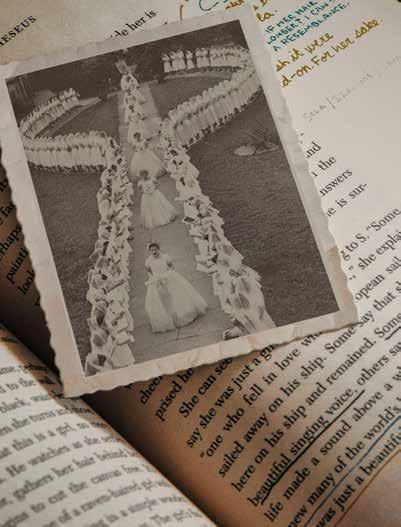
Arriving at Visitation as a sophomore in 1957, I felt the atmosphere was kinder, the academics were more rigorous, and the expectations were higher than anything I had experienced before.
The Sisters and the faith they inspired were a big part of every day. Sister Roberta was an awesome presence. From assembly in the Odeon first thing each morning to the end of the day, she seemed to be everything, everywhere, all at once. She was headmistress, college counselor, admissions director, religion teacher, chief disciplinarian, and more.
The connections I still have with Visi and my classmates are precious to me.
Sister Berchmans began teaching Latin in our freshman year and to this day recognizes our class as her first and, dare I say, favorite. With the help of a Muzzey textbook, Sister Theresa taught us American history, while Sister Ignatia had us memorizing passages from Chaucer in Middle English. Sister Virginia introduced us to Dickens and Word Wealth to increase our vocabularies. Mother Cecilia made biology memorable, and Sister de Sales was a very understanding math teacher. Well before she became known for advocating good posture, Sister Anne Marie ruled the Neale Shop.
While most of the school traditions we participated in came before us, such as Marshmallow Roast and Gold-White, our class did implement one lasting change. In our junior year, as we were ordering our class rings, several of us felt the ring style was too masculine so we designed a beautiful ring that is still the one worn by students to this day. Quite a legacy!
The late 1950s seemed uneventful, but there was a lot happening. World events were brought home to us with one student who fled the Hungarian Revolution of 1956 and another who was not able to return for our senior year due to the Cuban Revolution of 1959. It was also the beginning of the Civil Rights Movement that, over time, resulted in major changes in our country and heightened awareness of the legacy

of slavery. The earliest commercial computers were being developed and the space race began with the launch of Sputnik. Visitation prepared us well for these changes by encouraging us to consider these complex realities from intellectual, historical, and moral perspectives.
The connections I still have with Visi and my classmates are precious to me. My sister Mary Jo ’63 and my daughters Catherine ’85 and Liz ’88 are also alums and I enjoy additional connections through them and their classmates. Our five-year reunions have been a particular joy for me and have provided opportunities to renew friendships and to appreciate classmates I had not known well while in school. So many incredible women who have led amazing lives! And for almost seven decades of memories and connections, Sister Mary Berchmans has been there for us and for generations of alums. These are the blessings Visitation has brought me. •
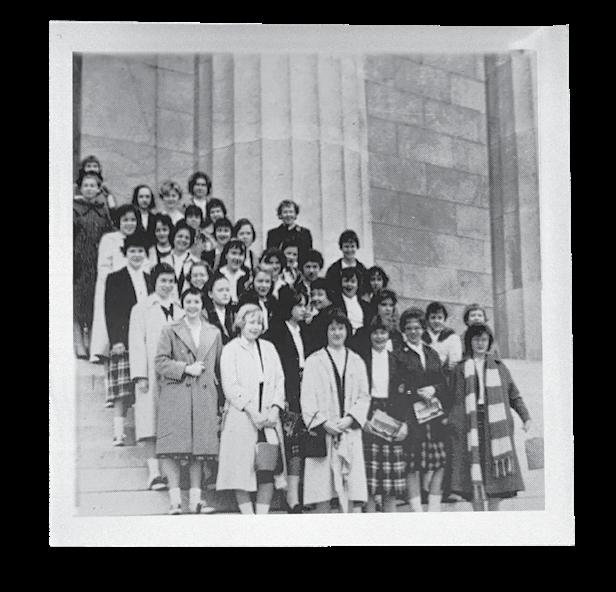
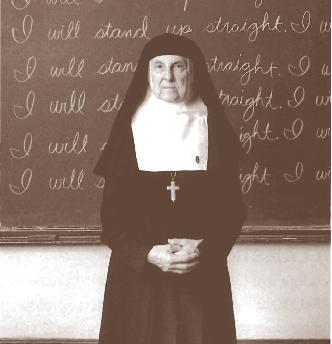
Sr. Anne Marie DiMenno

Upon being asked to write this article, my mind immediately went to a “Daisy Chain”-style. I can recall anxiously awaiting the Wicket to be published and going to the page with the column and readying myself for giggles and “uh ohs!” I have been most fortunate to witness Visitation over many decades, not only as a student and alum, but also as a parent and a member of the faculty. So, I’ve seen the changes over the decades and have to admit that perhaps the Administration recognized the cryptic and hysterical messages being sent via “Daisy Chains” and decided some things were better left unsaid. Without a chance of being suspended, I am going to bring them back just for this article.
GVC, our farewell is not the end. For the love we share lives on in our memories.
A senior in 1970, glad to have survived the 60s…the legendary Sister Roberta retired…Sister Mary Berchmans became headmistress…Jesuit colleges decided to admit women… began the relationships with Georgetown, Boston College…the Ivy Leagues were slowly beginning to admit women…we felt women were beginning to have a voice… Gold-White games were so much fun, particularly the night before…poster parties…decorating the gym…how many boxes of yellow and white tissues does it take to stuff 10 windows… tunics…Nicodemus…Woodstock in August of ’69…Kent State in May of ’70…shook up the sheltered-life perspective of some of us “Wise Fools” of the then sophomore class of ’72…sense of protection we felt within the walls and halls…circles of friendship…Motown played at the CYO dances…ponytails (never without ribbons!) adorned every head…while DC and the country were in the midst of great upheaval, the Visitation Sisters and our lay teachers were steady, relevant, and engaged…Miss Fairbanks/Mrs. Guzikowski…Sr. Claire Joseph… sweet Sr. Mary Virginia…Sr. Veronica’s typing class…what a place to do some all-girls growing up…junior year physics class field trip with the Sr. de Sales…“C’mon girls”…she said and out
we went…drag racing out the Dulles Toll Road…a stopwatch to record and compare braking distances with times…pulled over by the cops!…Sister’s smooth talking and ad-libbed explanation got us off the hook…class trip to Southern Maryland for a day by the bay…in full habit, Sister climbed aboard the speedboat…“Faster!” we all screamed…Sister’s entire wimple blew off…“Veil overboard!”…1972 shaking up a significant tradition…individual choice for the class ring stone… strong young women showing cooperative personal leadership…Marshmallow Roast…Mardi Gras…anticipation…the King and Queen with their court…class song with original words and a couple of guitarists…sitting on a couch with my mom for my admissions interview with Sr. Berchmans…senior 3-week work study…Sr. Baptista catching girls in the cemetery…junior research paper…aesthetics with Miss Elder…Marian Canney, not enough words in the world to capture the spirit and wisdom of this beautiful woman…gray, green, and white plaid box pleated skirts…saddle shoes…black, red, and yellow kilts… topsiders…locker room with a pay phone…buying tickets to see “Bread” in concert…vending machines with Nehi sodas…”The Exorcist” being filmed in Georgetown…boarders playing extras… Stuart Jay, our speech teacher, in the opening of the movie… scary movies in the Odeon…curfews when going out on weekends, and running back to make it home in time…hanging out in the Lodge after dinner…friendships made forever… afternoons and after dinner unstructured free time allowing us to walk into Georgetown or just hanging out in the Lodge… boarding school closes…a computer with enormous punch keys and ticker tape…automotive mechanics class…“You got it” “You did it” “I told you that you could do it”…retreats at Camp Maria… Sr. Berchmans’ continued strong and incredible leadership… faith…the Chapel…Mr. Ward…The Neale Shoppe…grilled cheese sandwiches for 25 cents…Shirley and Marva…Sr. Anne-Marie, the “out” nun…Sr. Theresa and her dogs…Mother Cecilia…Sr. Philomena…Sr. Mary Phillip…collecting 100 different insects for biology…G/W Banner…Class Cup…Field Day…senior pictures…picking our own graduation dresses (!)…Cor Jesu sung in parts…graduation in the Odeon…two pianos…red roses…long white gloves…”GVC, our farewell is not the end. For the love we share lives on in our memories.” •
Reflecting on my time at Visitation decades ago, I find myself journeying back through an experience that was highly transformative. I’m a graduate from the Class of 1983 and my years on 35th Street were encompassed by an academic environment that propelled my intellectual, spiritual, and personal growth. Unbeknownst to me at that time, it was simply a “practice” run that would create the future version of myself.
My professors and the school’s global curriculum cultivated discipline and resilience both on and off campus. Our teachers emphasized the importance of questioning, analyzing, and processing information from a variety of sources. For example, in history classes, we were taught to take a deep dive into the content, examining themes and historical contexts; all of which enhanced our ability to comprehend complex information. World current events offered continual learning.
One event that comes to mind was when some members from my class and other classmates, marched on the Washington Mall on a very cold January day in 1982 to support making Martin Luther King, Jr.’s birthday a nationally observed holiday. It was well worth the hours standing in the frigid temperatures to seek the long overdue recognition of a civil rights leader who taught that we are all equal and should not be judged by race. When it became an official holiday in 1983, I learned that, collectively, our voices mattered and brought about powerful change.
Visi is steeped in tradition, community, and service; all values which continue to shape my life. During my Christian service project in my senior year, I volunteered at Legal Counsel for the Elderly to care for a woman in her seventies who had no children, was a widow, and suffered from dementia. After school, I would visit her at her KennedyWarren apartment and maybe walk with her to the zoo or take her for a car ride to see different sites around town. I made sure she was clothed, fed, and content. My project was technically over when I graduated but I continued to visit with her until her death in 1992. Little did I know that it was “practice” for later years when I would care for my elderly mother. The ethos of giving back and of positively contributing to the world comes full circle.
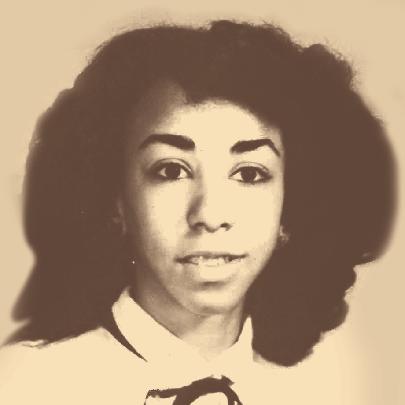
While at Visi, I developed many skill sets that were foundational in preparing me for the work world such as critical thinking, teamwork, problem-solving, leadership, networking, and communication, to name a few. I chose the information technology career field, which was inspired by my computer science classes with Mother Mary de Sales!
As Georgetown Visitation celebrates its 225th year, I am filled with gratitude for the education I received and its influence on my life. The sense of community and sisterhood formed bonds that are lasting, supportive, and real. GV’s legacy is evident not only in the academic excellence it nurtures, but in the way it teaches us to demonstrate our Christian values as women of faith, vision, and purpose. •

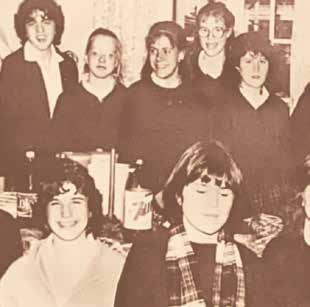

On the afternoon of July 8, 1993, the defining event of Visitation in the 1990s took place, when a fire roared through the main building, leaving little more than the main staircase in place–a symbol of the spirit that we would rely on in the confusion, excitement, and rapidly changing world of the 90s.
Many of us remember seeing the dramatic news footage of the flames and smoke billowing from the roof of the main building. Whether recent graduates or incoming freshmen, we were shocked and worried about what the fire would mean for our school. We quickly learned that no lives were lost, and many of our Monastery’s and school’s precious artifacts were saved. The resilient, hopeful, and Salesian spirit of the community shined, as we excavated blessing after blessing from the remains of the fire. A new sense of awareness emerged for those of us there in the 1990s—out of ashes come blessings, out of hardship comes triumph. In those days, we were faced with many challenges in the outside world, but perhaps more than ever felt the safety, optimism, and strength that Visitation provided for us.
Many graduates, students, and families gathered on campus to help with cleanup, offer support, and pray for our school. Friendships seemed more fast and strong during that time, teachers more human, our leaders and administrators more resolved. It was a fraught time, but also in a way more steady, more clearly defined, more laser-focused on a communal goal. Rebuilding was never a question, resilience never wavered. As young women observing the response to this dramatic event, we were undoubtedly influenced to be resilient in the face of challenges beyond the Green Gate.
When we returned to campus in September after the fire, we were greeted at the top of the hill with a little huddle of classroom trailers, which we called Founders Village. Those of us who were lucky enough to experience this time mostly agree that those trailers were cozy, cute, climate-controlled, and altogether a lovely time to make the best of an unexpected situation. Daily life consisted of the same traditions that bonded us as classmates and friends—Marshmallow Roasts, class retreats, and Gold/White. We learned our algebra and read our Dickens, but we also felt the changes and challenges of our generation—Gen X.
During the decade of slackers, riot grrrls, and teen angst, Visitation provided a nurturing environment for personal and academic growth. We recall a new kind of feminism in reaction to Anita Hill, Monica Lewinsky, and other high-profile scandals that redefined women in the workplace and the public sphere. While we absorbed values of sisterhood, service, and faith that continue to resonate to this day, we were also influenced by MTV and the birth of new musical genres like grunge and hip hop, two genres that defined the cultural landscape of the decade. The emergence of these musical movements provided a soundtrack to our coming of age, shaping our identities and influencing our experiences in profound ways. The rise of grunge music, with its raw, angst-filled sound, resonated deeply with many of us navigating the tumultuous terrain of adolescence. The explosion of hip hop culture brought with it a new wave of artistic expression and social consciousness. It enthralled us with powerful storytelling, activism, and cultural empowerment. Hip hop’s celebration of diversity and its unapologetic embrace of urban culture challenged us to confront our own biases and expand our understanding of the world beyond the confines of Visitation. From the Neale Shoppe to the Senior Lodge, discussions about favorite bands and the latest albums became a form of socializing. We always had a radio/CD player in the Playroom and the Lodge and shared our favorite music in our downtime. Through music, videos, and the birth of the Internet, we witnessed the objectification of women in a way no other generation had before. We felt called to represent our Visitation values, yet also felt the need to speak up in a world that seemed bent on objectifying and devaluing women. At Visitation, we learned to trust in our spirits and respect our bodies. In the 90s, we were ready to stand up to a world that was changing rapidly.
By 1996, the main building reopened, christened Founders Hall, ushering in a new era of technology (and air conditioning!), just as the Internet was changing the face of education and society as we knew it.
As the 90s continued, we were buffeted by social change and unexpected challenges outside our campus walls, but we like to think that the lessons we learned during the fire gave us the strength to know how to endure with optimism and spirit.•
“Be who you are and be it well.” This well-loved dictum of St. Francis de Sales is one we heard often as students, at a time when we were still sorting out exactly who we were and wanted to become. On graduation day, as we walked through the Green Gate, we knew we were young women who were confident in our excellent education; spiritually secure in our identity as God’s cherished daughters; and assured that Visitation would always be our home, the Sisters welcoming us back with open arms and offers of their prayers.
Our calm, quiet years of learning at Visitation prepared us well for a future that would unexpectedly confront us in the decade after graduation: a terror attack on American soil that killed over 3,000 people; the deadly and complicated wars in Afghanistan and Iraq; tsunamis and hurricanes that wiped out poor communities; civil wars in struggling nations; and racist attacks by Americans against Americans. To survive these developments as well as the normal challenges of young adulthood, we needed to be women of faith who could offer hope in the midst of darkness and doubt; to be women of vision who could see a better world; and to be women who purposefully channeled their strengths for the good of others.
Visi prepared me well for the all-women’s Smith College, where I was a sophomore on 9/11. My close group of Visi friends were at schools in New York City. On that fateful Tuesday and over the ensuing weeks and months, we rallied together—first over AOL Instant Messenger and ultimately
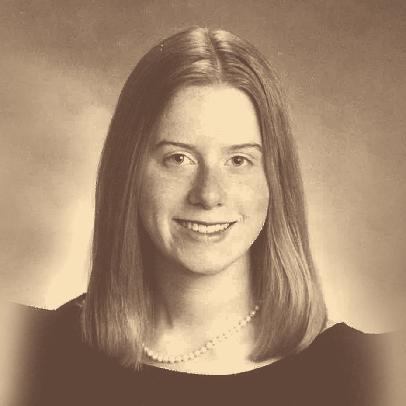
together in the city—keenly aware of the growing complexity of the wider world and our role in it.
I decided I wanted to serve my country and to protect it as best I could. After obtaining my MA from Georgetown, I joined the Central Intelligence Agency as a clandestine officer, and served in the Middle East and North Africa.
As my 10th Visi reunion neared, I was in Baghdad, desperately hoping to catch a flight home after volcanic ash had grounded air travel. I just barely made it back in time and despite the surrealness of being in a war zone one day and on Visi’s campus the next, it felt so good to be “home” and surrounded by my amazingly brilliant and hilarious classmates. I proudly elicited a laugh from one of the Sisters: when she asked if I was scared overseas, I assured her I was always armed.
Beyond 2010, I would segue into new careers—interviewing heads of state, UN officials, and rebel groups as a reporter for United Press International, writing over 2,500 articles from Washington and overseas. I attribute my modest journalistic success to Visi’s demanding English teachers and the merry times I had on the Wicket. Later, I worked in international development, supporting the Syrian moderate opposition both from Washington and on the Syria-Turkey border. We Visi women root for the oppressed and fight for justice. I now work in technology for a company committed to strengthening our national security by empowering the warfighter.•
On graduation day, as we walked through the Green Gate, we knew we were young women who were confident in our excellent education; spiritually secure in our identity as God’s cherished daughters; and assured that Visitation would always be our home, the Sisters welcoming us back with open arms and offers of their prayers.

As I’m writing this, I’m traveling to the Caribbean with my favorite travel pieces: a Visi senior sweatshirt, Visi keychain, Visi luggage tag, and maybe there’s even some Visi swag in my purse. Attending Visi opened my eyes to the possibilities and opportunities for a young Black woman. And there I learned, I can and deserve to have it all.
Being immersed in tradition allowed me to understand the meaning of being a part of an esteemed historic community. As one of a handful of Black women, I was anxious to join the prestige of Visi, where my peers, teachers, and the photos of Visitation past didn’t look like me. However, when I thought I couldn’t succeed there were mentors such as my older sister Tiffany Bullock ’08, Tiffany’s friends, and Mrs. Clay who believed I could. I was exposed to a different caliber of success and wealth at Visitation and was welcomed and included. I’m elated that Visitation is a part of the tapestry of my life. I truly do not believe that I would be the woman I am without those four years.
Becoming a woman of faith, vision, and purpose is something I didn’t realize I needed at 13. However, being at an all-girls school made that transition more achievable and impactful. As an insecure teenager, I was able to do weird dances and make the corniest jokes in the halls, all while
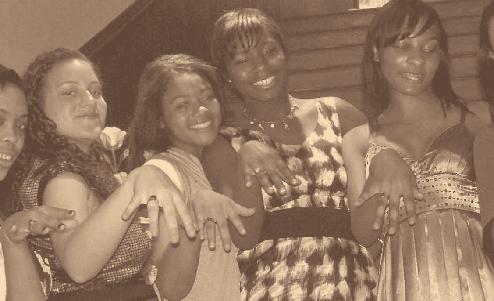
making a complete fool of myself without judgment. But that was Visi. We work hard, we play hard, and we laugh even harder. It’s a sanctuary to grow and develop from an awkward 13-year-old to a poised 17-year-old. As an adult, I get asked many times, “Where did your confidence come from?” and “How are you able to navigate the traditionally white male dominated world of finance?” The answer is and always will be Visitation.
In addition to being Black and female—key facets of my makeup—I would be remiss if I didn’t mention intelligence. Visitation was academically the hardest time in my life. The academic rigor wasn’t as strenuous in middle school and, little did I know, neither was university (shout out to the U though!

I’m elated that Visitation is a part of the tapestry of my life. I truly do not believe that I would be the woman I am without those four years.
It was difficult, but Visi was harder!). At a young age I was told I was extremely intelligent and will go on to do great things because I am a Visi girl. At Visitation, greatness is expected every day, whether my teachers expected me to be better than I was last year or my track team expected me to continue to break records. It was the first time I did something without the guarantee of success. I was no longer the big fish in a little pond. Visi helped me realize if you trust in faith and execute strategically, you can beat any Goliath.
I entered adulthood as a woman with not only faith in myself to accomplish my goals, and the vision that dreams do not have glass ceilings, but also a purpose: to leave this world better than I found it. Visitation taught me that nothing’s unattainable if I put my mind to it, which reminds me of my senior quote: “NEVER let anyone take up your pen and become the author of your life. We are only supporting characters and the rest is still unwritten.” •
As a 17-year-old girl, it was beyond my awareness how well my Visitation education would prepare me for life away from 35th Street. At my desk in Villanova, Pennsylvania, I am always leveraging the academic skills I learned at Visi. I have my Visitation teachers to thank for everything—my note-taking skills, my multitasking capacity, my persistence with a mind-stumping problem, and my ability to transform a blank page into a masterpiece.
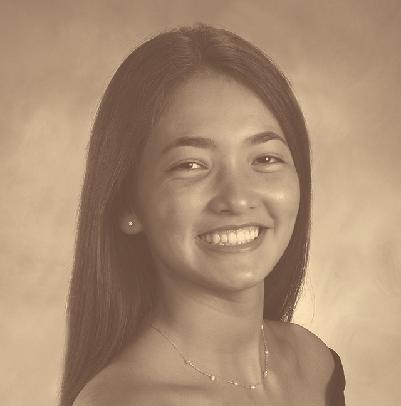
quo Visitation experience. Covid swept through everything that was our whole world as high-schoolers, and there was nothing we could do to stop it.
I can speak for the walls when I say that the years between 2017 and 2021 were something special indeed. I knew what it was like to be a Visi girl both pre-Covid and during, which made it all the more difficult to be disappointed by the beloved Visitation traditions looking different than we had expected.


Beyond academics, however, I credit who I am today— my character—to my four years at Visitation. My wide-eyed, concerned, and blank-slate younger self who walked into Founders with a shy smile would not have recognized the creatively confident, self-assured, and ready-to-rock graduate that strode through the Green Gate upon commencement. All this to say: without the girls and faculty I met along the way to graduation, I would not have learned valuable lessons in friendship, independence, and tenacity that I am quick to call upon for guidance in my academic, faith, and social lives at college. For this, I am forever grateful to Georgetown Visitation.
I wonder what the Visitation walls would say about its girls between the years of 2017 and 2021, if they could speak. A spunky bunch, we were strong-willed and unyielding, with growing personalities, always challenging our teachers despite the way things had been done before. Unbeknownst to us, we would get exactly that: something different from the status
Hours spent with student government trying to craft an online or Covid-safe version of the traditions that we had come to not only love but also to look forward to wholeheartedly was an almost impossible task.
The collaboration of student leaders and willing faculty who were ready to go the extra mile to be creative allowed for our class to leave our own legacy behind. Being on the student government team that adapted Visitation to Covid was a ginormous task for 17-year-old girls, but as a result I was able to fight the time that Covid tried to steal from me, make more memories with my best friends in our home away from home, and learn more from time spent with our favorite teachers. “Promenade,” our outdoor take on an exclusively senior girls prom, was something that Visitation had surely never seen before, and it was uniquely ours.
As my little sister Reagan joins the Class of 2028 this fall, I couldn’t be more excited for her to be a Visi girl and make her own mark within the Visitation walls. Four years at Georgetown Visitation was the most special gift I could have received, and I cannot wait to see how time will treat the next spunky bunch of girls to set foot on 35th Street.
I credit who I am today— my character—to my four years at Visitation.